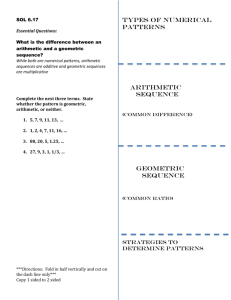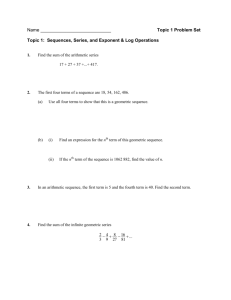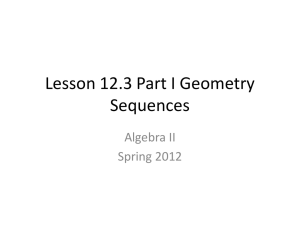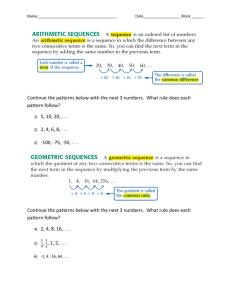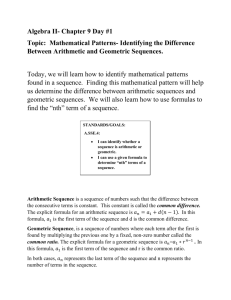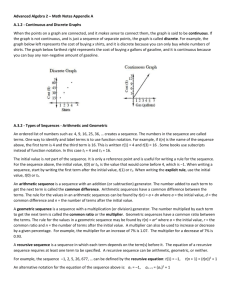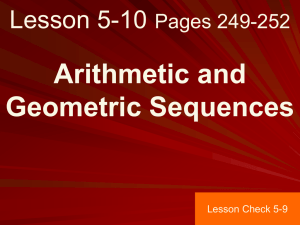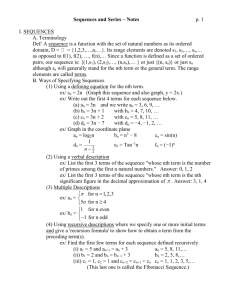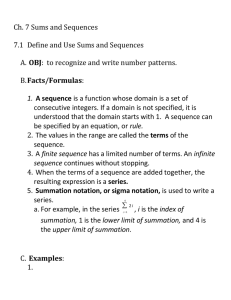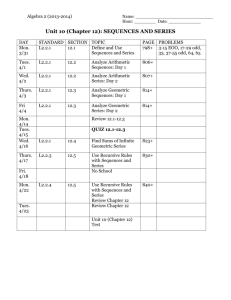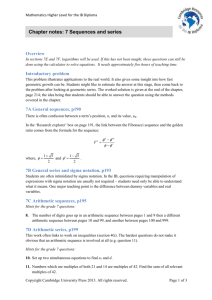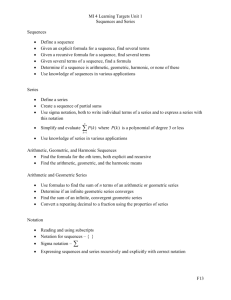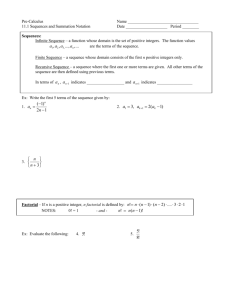Module 9 Lesson 2 Arithmetic and Geometric Sequences
advertisement
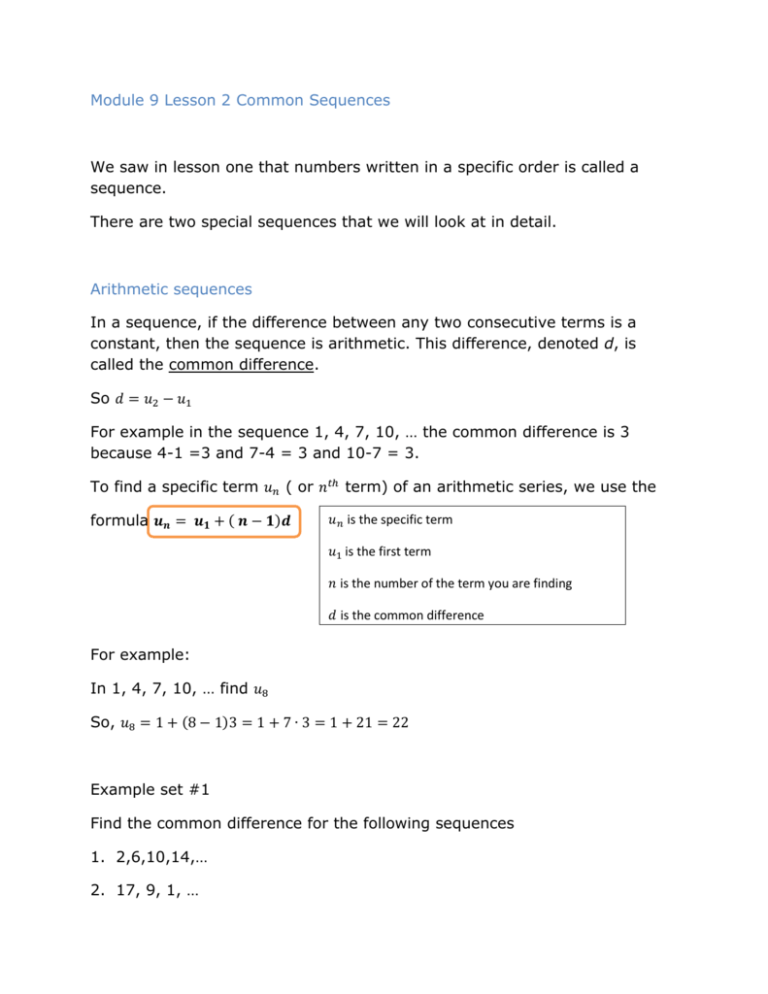
Module 9 Lesson 2 Common Sequences We saw in lesson one that numbers written in a specific order is called a sequence. There are two special sequences that we will look at in detail. Arithmetic sequences In a sequence, if the difference between any two consecutive terms is a constant, then the sequence is arithmetic. This difference, denoted d, is called the common difference. So 𝑑 = 𝑢2 − 𝑢1 For example in the sequence 1, 4, 7, 10, … the common difference is 3 because 4-1 =3 and 7-4 = 3 and 10-7 = 3. To find a specific term 𝑢𝑛 ( or 𝑛𝑡ℎ term) of an arithmetic series, we use the formula 𝒖𝒏 = 𝒖𝟏 + ( 𝒏 − 𝟏)𝒅 𝑢𝑛 is the specific term 𝑢1 is the first term 𝑛 is the number of the term you are finding 𝑑 is the common difference For example: In 1, 4, 7, 10, … find 𝑢8 So, 𝑢8 = 1 + (8 − 1)3 = 1 + 7 ∙ 3 = 1 + 21 = 22 Example set #1 Find the common difference for the following sequences 1. 2,6,10,14,… 2. 17, 9, 1, … 3. x, x+y, x+2y, x+3y, … Find 𝑢12 for the following sequences. 4. 8, 6, 4, … 5. -4, -11, -18, -25, … Arithmetic Series The sum of an arithmetic series can be found using the formula: 𝑛 𝑆𝑛 = 2 (𝑢1 + 𝑢𝑛 ) For example, find the sum of the first 8 terms of -1, 2, 5, 8, … We know that 𝑛 = 8,and 𝑢1 = −1 We need to find 𝑢8 . Utilizing the previous formula, 𝑢8 = −1 + ( 8 − 1)( 3) = −1 + 7 ∙ 3 = −1 + 21 = 20 Now 𝑆8 = 8 2 (−1 + 20 ) = 4 ( 19 ) = 76 Exercise set #2 1. Find 𝑆12 for 12, 6, -6, 0,… 2. Find 3+ 8+ 13 + 18+ ….+ 38 Geometric Sequences The second special sequence is the geometric sequence in which the ratio between consecutive terms is constant. This ratio, r, is called the common 𝑢 ratio and can be calculated by dividing the second term by the first, 𝑟 = 𝑢2 . 1 The 𝑛𝑡ℎ term of a geometric sequence can be found by using the formula 𝑢𝑛 = 𝑢1 𝑟 𝑛−1 𝑢𝑛 = nth term 𝑢1 = first term 𝑟= common ratio The sum of n terms is 𝑆𝑛 = 𝑢1 (1−𝑟 𝑛 ) 1−𝑟 Example set #3: Given 16, 8, 4, 2, 1, ½, … Find a) 𝑢8 b) 𝑆8 An infinite geometric series is a special type of geometric series. Let’s look at a sequence with a common ratio of ½. If we start at 2, then the sequence would be: 2, 1, ½, ¼, 1/8, 1/16, 1/32, 1/64, 1/128, 1/256, … The sequence would never end, however we would never reach zero. Each individual term is getting smaller and smaller, closer and closer to zero. If we now look at the series: 2+ 1+ ½+ ¼ + 1/8 + 1/16+1/32+1/64+ 1/128 + 1/256+… We might ask how could we find a sum of a series that never ends? Let’s look at partial sums of the series. 2+ 1=3 2+ 1+ ½=3.5 2+ 1+ ½+ ¼=3.75 2+ 1+ ½+ ¼ + 1/8=3.875 2+ 1+ ½+ ¼ + 1/8 + 1/16=3.9375 2+ 1+ ½+ ¼ + 1/8 + 1/16+1/32=3.96875 2+ 1+ ½+ ¼ + 1/8 + 1/16+1/32+1/64=3.984375 2+ 1+ ½+ ¼ + 1/8 + 1/16+1/32+1/64+ 1/128=3.9921875 2+ 1+ ½+ ¼ + 1/8 + 1/16+1/32+1/64+ 1/128 + 1/256=3.99609375 As you can see, just by adding the first 10 terms, the sum changes very slowly. What would happen if we added the first 100 terms? The sum would change so insignificantly that it would be essentially adding zero each time. When the consecutive terms of an infinite geometric series get smaller and smaller, the common ratio would have to be between -1 and 1 or |r| < 1. The formula for finding the sum of an infinite geometric series when |r|<1 is 𝑢1 𝑆∞ = 1−𝑟 So in our example, the sum would be calculated by Example set #4 Find the infinite sum, if it exists 1. 1 25 1 1 + 250 + 2500 + ⋯ 2. 3+ 9+27+… 2 1−1/2 2 = 1/2 = 4. Answers for exercise set #1 1. d= 6-2 = 4 2. d = 9 – 17 = -8 3. d = x + y – x = y 4. 𝑢12 = 8 + ( 12 − 1)( −2 ) = 8 + 11 (−2) = 8 + −22 = −14 5. 𝑢12 = −4 + ( 12 − 1 )( −7) = −4 + 11 ( −7 ) = −4 + −77 = −81 Answers for exercise set #2 1. 𝑆12 = 12 2 (12 + 78) = 540 2. 164 Answers for exercise set #3 1 8−1 1. 𝑢8 = 16 (2) 2. 𝑆8 = 18 ) 2 1 1− 2 16(1− = 1 7 1 = 16 (2) 16 (128) = 16/128 255 ) 256 1 2 16( = 32 ( 255/256) Answers for exercise set #4 1. 1 25 1 1− 10 2 =45 2. No sum since r=3 which is greater than 1.



